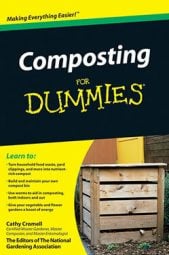At last, you're ready to start piling up the goods. You can speed decomposition by creating a pile of optimum proportions and prepping ingredients before tossing them on the heap. The basics of building your pile are included here.
A pile that's 1 cubic yard in size can heat up sufficiently to kill most weed seeds and plant pathogens, but only if you maintain it properly. You must create a specific pile type and maintain it rigorously in order to kill weed seeds and plant diseases.
Prepping compost materials
Chop, break, and shred most of the material into small pieces. RemembeR: The smaller the pieces of organic matter in your compost, the faster the rate of decomposition. There doesn't have to be anything tidy or uniform about it. Your goal is to offer as many entry wounds as possible for critters to attack. Incorporate these routines into your garden cleanup:
Break thin branches over your knee or cut them into smaller pieces with hand pruners and loppers as you prune.
Chop weeds with a hoe or square-bladed spade.
Tear apart spent annuals as you pull them from the garden with your gloved hands.
Set aside an area for chopping refuse with a hatchet or machete (an excellent stress reducer, by the way). Use smooth, flat ground surface or a large tree stump. Wear protective safety glasses when chopping.
Consider renting or buying a chipper/shredder if you have lots of woody material to deal with.
Although most of your compost material should be small pieces, it's okay — even beneficial — to allow some bulk to remain to provide air pockets. If all the contents of your pile are tiny, compacted bits, they compress and form impenetrable mats, reducing the ability of oxygen to circulate through the pile.
Piling on the layers
When it comes to constructing a compost pile, you can alternate layers of browns and greens like a chocolate layer cake, or toss everything together like a giant chopped salad. Generally, the more mixed up the ingredients, the better the overall decomposition, because different ingredient layers can decompose at different rates. But layering is usually easier for most folks. Layer your pile as follows, starting at the bottom:
Start with 4 inches of chunky browns (sticks, woody trimmings, dried perennial stems, cornstalks, and the like) to promote aeration at the bottom.
Add 4 to 5 inches of other browns (leaves, straw, woody trimmings, paper products, pine needles, sawdust).
Add 2 to 3 inches (5 to 8 centimeters) of greens (kitchen scraps, grass clippings, leafy plant trimmings, manure).
Repeat Steps 2 and 3 until you reach a pile height of 3 to 5 feet. Finish with a top layer of browns to insulate.
Whether you layer or mix your compost pile isn't really that big of a deal. The more important issue is to ensure that all your recipe ingredients are sufficiently moist as you build.
Use a hose with an on/off spray attachment, and sprinkle each layer (or every 10 to 12 shovel- or pitchfork-loads) of organic matter as you build. Everything should have the moisture level of a wrung-out sponge, so grab a handful every once in a while as you build to test it.

